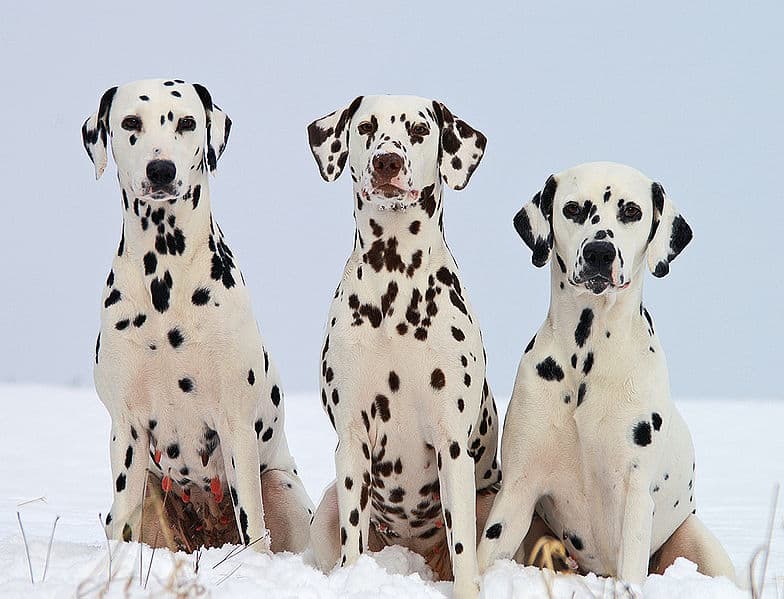In their earliest days, Dalmatians often traveled alongside humans, guarding horses and stagecoaches. They boast superb stamina and energy, alongside the ability to adopt close bonds with their family members. Although they are often wary of strangers due to their original purpose of detecting threats, they are overall friendly dogs when socialized properly. However, how do these features vary between male vs. female Dalmatians?
To learn the answer to this question and more, continue reading below!
Male vs Female Dalmatians: Key Differences
| Height | Weight | Dependency | Trainability | |
| Male Dalmation | 21–23 Inches | 50–60 pounds | Dependent | Average |
| Female Dalmation | 19–22 inches | 45–55 pounds | Independent | Above Average |
Based on appearance alone, male and female Dalmatians look quite similar. However, males are both taller and heavier than females. They also have a tendency to have a higher muscle mass than females, sometimes giving them a bulkier or more robust appearance than their female counterparts.
Emotionally and based on personality, however, there are several differences between male vs female Dalmatians. For instance, male Dalmatians are thought to have a lower level of intelligence than female but a higher drive to please their owners. Female Dalmatians typically have a better understanding of commands, but they are less eager to please than their male counterparts.
It is important to remember that genetics play only a small part in the differences between male vs female Dalmatians. Upbringing and training will also determine their personality, while diet and exercise can impact their weight. Individuals of each sex will also vary, with males and females possessing different physiques and personalities depending on the individual.
Height

Male Dalmatians tend to grow taller than females.
©iStock.com/Bigandt_Photography
As with most dog breeds, male Dalmatians are larger than females. This includes both height and weight.
Adult male Dalmatians can grow to be up to 23 inches at the shoulder on average. The average minimum shoulder height for males of this breed is 21 inches. At their average tallest, however, female Dalmatians only grow to a height of 22 inches. The lower end of this spectrum has the female’s height at 19 inches. As a result, there can be as much as a four-inch difference between the smallest female Dalmatians on average versus the tallest average male.
Weight
Because male Dalmatians are taller than females, they often weigh more. It is important to remember that weight relies on diet and exercise as much as it does genetics, so the exact weight of individuals can vary greatly.
However, on average, adult male Dalmatians will maintain a healthy weight between 50 and 60 pounds. Female Dalmatians, on the other hand, tend to average around 5 pounds lighter, with an adult weight ranging between 45 and 55 pounds total.
Dependency

The attachment styles of Dalmations can vary based on male vs female.
©iStock.com/Eudyptula
Male Dalmatians are more dependent on their owners than females. They prefer spending time with their family members and may be more prone to developing separation anxiety. Females of this breed are independent but still loving. They can be content in any situation, whether that is spending time with you or hanging out alone.
The exact dependency of a dog will vary on their socialization, training, and personality. Reactive dogs, anxious dogs, and those lacking confidence may be more prone to dependency regardless of breed or sex. Regardless of personality and dependency, all Dalmatians need adequate exercise and quality time each day. All dogs are capable of developing separation anxiety and destructive tendencies without proper care and training.
Trainability
Of the two, females are considered to be more intelligent than males. They learn commands and their name more readily. However, the female Dalmatian is also far more independent than her male counterpart on average. Because of this, while she is more trainable in the sense of intelligence, she lacks the male’s eagerness to please. This means she may hear and understand a command but be less likely to follow it in some situations.
Males, however, are eager to please their owners. They may struggle more with learning commands, but once learned, they’ll be more than happy to show off their skills. However, when it comes to learning and responding to their names, be warned. Male Dalmatians are known to have a wanderlustful personality, leading them to wander occasionally. Ensuring that they have proper recall skills can be a must with this breed.
Strength

Dalmations are a strong breed regardless of male or female, but males tend to be stronger on average.
©Dalmatiner24.eu – Public Domain
With larger heights and weights, male Dalmatians have more muscle mass than females, typically. This can lead to greater levels of strength. However, this isn’t to say that female Dalmatians are weak by any means.
Regardless of male or female, Dalmatians pack a genetic history full of breeding the strongest, most agile individuals to produce perfect working companions. Because of this, even though females may be less strong than male Dalmatians on average, their strength isn’t to be taken lightly.
The photo featured at the top of this post is © Megan Betteridge/Shutterstock.com
Ready to discover the top 10 cutest dog breeds in the entire world?
How about the fastest dogs, the largest dogs and those that are -- quite frankly -- just the kindest dogs on the planet? Each day, AZ Animals sends out lists just like this to our thousands of email subscribers. And the best part? It's FREE. Join today by entering your email below.
Thank you for reading! Have some feedback for us? Contact the AZ Animals editorial team.






